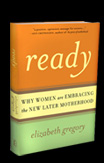





 If I could think of a topic that travels around the conversations of most women I know, the choice to have a child, and when, often lives pretty near the top of the list. Following it comes a litany of concerns: how to juggle career, partnerhood, personal and professional ambitions, and more. Elizabeth Gregory, Director of the Women’s Studies Program at the University of Houston, as well as Full Professor of English, tackles the topic of timing in Ready: Why Women are Embracing the New Later Motherhood with results that bring relief — both in the sense that there is good news to uncover amid all the swirling anxiety, and relief as the strong, clear reasons why many women choose to delay motherhood stand out against a grey fog of cultural pressure that warns against it.
If I could think of a topic that travels around the conversations of most women I know, the choice to have a child, and when, often lives pretty near the top of the list. Following it comes a litany of concerns: how to juggle career, partnerhood, personal and professional ambitions, and more. Elizabeth Gregory, Director of the Women’s Studies Program at the University of Houston, as well as Full Professor of English, tackles the topic of timing in Ready: Why Women are Embracing the New Later Motherhood with results that bring relief — both in the sense that there is good news to uncover amid all the swirling anxiety, and relief as the strong, clear reasons why many women choose to delay motherhood stand out against a grey fog of cultural pressure that warns against it.
Over two and a half years, Gregory interviews 113 women of diverse backgrounds (gay and straight as well as single and coupled) and focuses on the choices of women who become first-time mothers at age 35 or older. Recognizing that “later” motherhood is nothing new, Gregory articulates how the difference is that women are now choosing to have first children, rather than last, at what is labeled “advanced maternal age.” The choices that spur this change swim the currents of women’s lives: the advent of birth control, and correspondingly, advances with fertility treatment; access to education and the desire for a career; refusal to marry just to gain a spouse, with instead the desire to wait for a peer relationship; commitment to financial security that eschews dependence on a partner. The best news is how often the women interviewed express deep contentment with their paths.
Gregory’s statistics are compelling: “One of every 12 babies born to first-time mothers in 2006 was born to a woman 35 or older. In 1970, the figure was one in 100.” Her research reflects the financial as well as emotional rewards of this choice. She points out that “among full-time workers between 40 and 45 with professional degrees, those who had their first child at 25 made an average of $46,000, while those who waited until 35 made $79,000. A woman’s average long-term salary increases by 3 percent for each year she delays children.” Her exploration of the politics surrounding labor (during birth and other maternal work) and childcare issues continues on her blog “Domestic Product” and in several thought pieces available online.
Ready rounds a spectrum of reasons why women choose to delay, with many citing better emotional preparedness at later ages, as well as not wanting to rush new relationships, or women’s own enjoyment of their 20s and 30s, alongside the desire to be more financially powerful and advanced in their careers, hence better able to leverage work/family balance. Women who come later to motherhood are more likely to have higher levels of education, more stable partnerships, and be in “peer marriages,” with active partners who commit equally to childcare. Most cheering is the overall positive sense of choice.
Gregory does not deny statistics around declining fertility for older, aspiring first-time moms, but takes issue with the cultural narratives that pronounce definitive limits that may not hold true for every body. Commenting that the advent of tabloid profiles of older stars having babies at advanced ages, combined with medical warnings to women not to delay childbearing, have created a confusing scenario where “people seem to think simultaneously that nobody can get pregnant after 35 and that everybody can,” Gregory brings back mention of the “punishment narrative” Sylvia Hewlett raises in Creating a Life, which “linked high-achieving women with infertility and warned younger women not to trade their hopes of family for lonely success.”
Similarly, we now have the expectation of an “emergency mood” offered on many fertility clinics’ websites — alongside promotion of their services meant to lure patients in with anticipation of failure. Gregory is clear about how fertility may wax and wane off the standardized charts but her scrutiny of the cultural scripts around waiting, combined with who and what ideals are served by telling women not to wait, is revealing. She comments how the “tangled dynamics of the current fertility scene jumble together parents’ desire for a child and the doctors’ and the pharmaceutical companies’ joint motives — both to assist potential parents and to make a profit” while still being frank about the issues women may face. Her study includes women well above 40 who become first-time mothers, some through donor eggs, some through adoption, and some naturally, also noting that some lament that their age delimits having more than one child.
Neither directly advocating later motherhood, or not, Gregory reveals how “ready” holds a variety of nuances, but reversing the cultural chime of anxiety and panic about postponing childbearing to show instead that women who come to motherhood later in their lives report high levels of satisfaction, contentment, overall strong work/family balance and often genuine joy with their choices is a welcome shift.


Comments